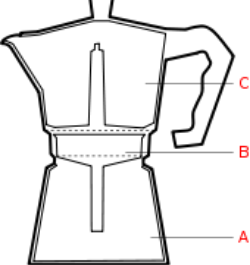How to make the Perfect Espresso
Date Posted:6 March 2018
Coffee is the beverage of the creative and active intelligence. It revives and awakes the senses. This is the reason why it is one of the most consumed products in the world. The traditions, rituals and preparation methods differ from one country to another.
Fill the boiler (marked A in the diagram) with water almost up to the safety release valve and insert the funnel-shaped metal filter (B). Add finely-ground coffee to the filter as shown below. Tightly screw the upper part (C, which has a second metal filter at the bottom) onto the base. Place the pot on a suitable heat source, bring the water to its boiling point, and thereby create steam in the boiler.

A gasket ensures a tightly closed unit and allows for pressure to safely build up in the lower section, where a safety valve provides a necessary release in case this pressure should get too high (with clean filters, that should not happen). For best results, fill up the entire filter with coffee and place over medium to medium-high heat.
The steam eventually reaches a high enough pressure to gradually force the surrounding boiling water up the funnel through the coffee powder and into the upper chamber (C), where the coffee is collected. When the lower chamber is almost empty, steam bubbles mix with the upstreaming water, producing a characteristic gurgling noise.
As with percolators, the pot should not be left on the stove so long that the coffee boils. Ideally, with a little practice, it should be removed from the heat before it actually starts gurgling - usually, when only about half of the top chamber has been filled.
Additional Infomation
Your coffee maker begins to work when heat is applied to the base causing heat to build up in the lower chamber. (Many believe that the water begins to rise only when the water reaches boiling point however this is not the case). It actually works by heating the air causing it to expand and force the water through the funnel and into the upper chamber. This begins to occur at a temperature of 500C and will end at a temperature of 900C. The end result is a perfect coffee at 700C which, depending on the heat source, will be brewed in approximately 5 – 10 minutes.
TIPS and TRICKS
For the first use, discard the coffee as it will help to eliminate foreign particles and production odours.
Percolators have heat resistant handles, however these handles are not flame proof therefore avoid heating on high flame as it may damage the handle.
Any type of coarse ground espresso coffee can be used. Do not use instant coffee, cocoa, fine ground coffee, or flavour extracts.
Do not use abrasive soaps, powders or steel wool products. Never wash your percolator in the dishwasher, as it may alter the aluminium surface. For cleaning simply use water.
Never use your percolator without water.
Store away only after all items are dry to avoid calcium build up






